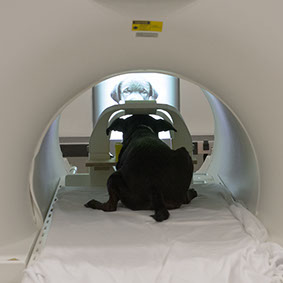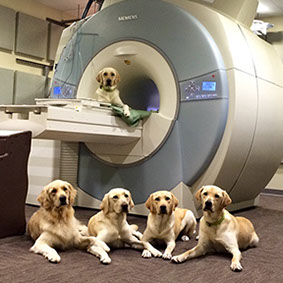GREGORY BERNS M.D. / Ph.D.
The Dog Project

Dogs have had a prolonged evolution with humans. Because of this, many of their cognitive skills are thought to represent a selection of traits that make dogs particularly sensitive to human cues. But how does the dog mind actually work? To answer this question, researchers at Emory University and Comprehensive Pet Therapy have been trainings dogs to lay still in an MRI – completely voluntarily and without sedation.
The “Dog Project” began in 2012. Initially, two dogs were trained using positive reinforcement. The dogs learned to hold an extended down-stay in a custom-made chin rest inside a simulated MRI. They also learned to wear ear protection to guard against the noise an MRI makes as well as becoming acclimated to the sounds. Within a few months, we had performed the first scans in the world. We demonstrated that the reward system of the dog’s brain could distinguish between hand signals that meant the presence or absence of a food reward.
With over 80 dogs trained for awake-MRI, these dogs can sit for an MRI with less effort than it takes for an X-ray. Unfortunately, as they age, they will develop health problems, and up to half of them will develop cancer. We have begun a health-screening program that monitors for the early development of cancer, not only in the brain, but throughout the body. If more dogs were trained for MRI, we could change the way cancer is treated. Instead of being a largely palliative procedure, early detection through awake-MRI could make many of these cancers curable. Already, we have detected cancer in two dogs and facilitated early treatment. We can do better. Imagine if ALL dogs were able to sit for an MRI without sedation or anesthesia.

PUBLICATIONS
- Berns GS, Brooks AM, Spivak M, Levy K: Functional MRI in awake dogs predicts suitability for service work. Preprint.
- Cook P, Prichard A, Spivak M, Berns GS: Awake canine fMRI predicts dogs' preference for praise versus food. Soc. Cog. Aff. Neurosci., in press. Link.
- Cook PF, Spivak M, Berns G: Neurobehavioral evidence for individual differences in canine cognitive control: an awake fMRI study. Anim Cogn, 19:867-878, 2016. Link. PDF.
- Dilks DD, Cook P, Weiller SK, Berns HP, Spivak M, Berns GS: Awake fMRI reveals a specialized region in dog temporal cortex for face processing. PeerJ, 3:e1115, 2015. Link. PDF.
- Cook PF, Spivak M, Berns GS: One pair of hands is not like another: caudate BOLD response in dogs depends on signal source and canine temperament. PeerJ, 2:e596, 2014. PDF. Link.
- Berns GS, Brooks AM, Spivak M: Scent of the familiar: an fMRI study of canine brain responses to familiar and unfamiliar human and dog odors. Behavioural Processes, 2014. Link.
- Berns GS, Brooks A, Spivak M: Replicability and heterogeneity of awake unrestrained canine fMRI responses. PLoS ONE 8(12):e81698, 2013. Link.
- Berns GS, Brooks AM, Spivak M: Functional MRI in awake unrestrained dogs. PLoS ONE 7(5):e38027, 2012. Link. PDF.
Copyright © 2016 Gregory Berns | Web Design by Madeline Berns